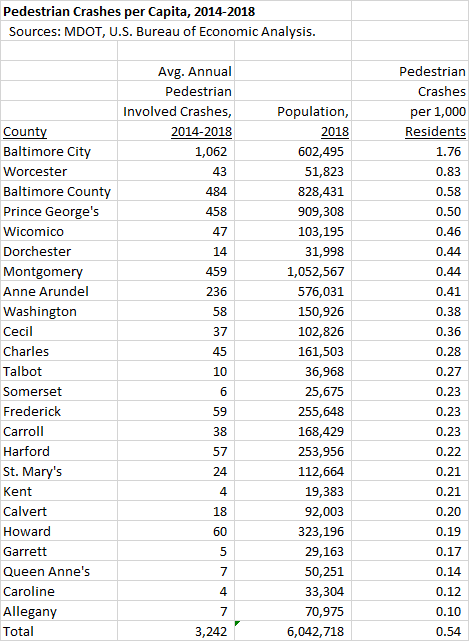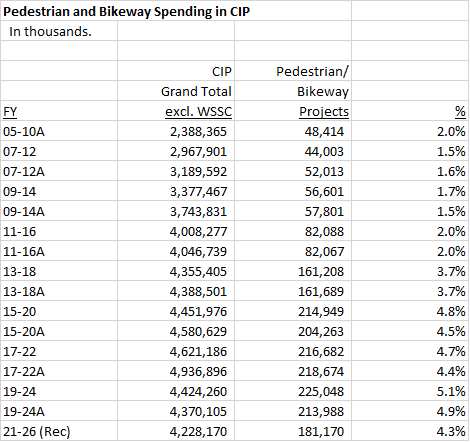By Adam Pagnucco.
Pedestrian safety is arguably THE hottest issue in MoCo government right now. With several recent high profile pedestrian deaths and residents swarming a county council meeting on the subject, alarmed elected officials are terming pedestrian crashes a “public health crisis” and demanding action. The county has responded by hiring a full-time pedestrian safety coordinator and is promising more to come.
Pedestrian safety has been a challenge in Montgomery County for decades. How well is the county doing on this issue?
First, let’s look at MoCo’s rate of pedestrian involved crashes in comparison to the rest of the state. The table below, sourced from data provided by the Maryland Department of Transportation, compares the average annual number of pedestrian crashes by county to county populations.

Three of the top four counties on a per capita basis – Baltimore City, Baltimore County and Prince George’s County – are among the most urbanized jurisdictions in the state. The other county in the top four – Worcester – has an unusual amount of pedestrian activity on the Ocean City boardwalk. MoCo ranks 7th of 24 counties on crash rate but its average annual crash rate per 1,000 residents (0.44) is below the state average (0.54). Admittedly, the state average is skewed upwards by Baltimore City.
It’s interesting that MoCo’s pedestrian crash rate is similar to less urbanized jurisdictions like Wicomico, Dorchester and Washington Counties. Urbanized counties should have greater volumes of pedestrian activity because of a greater abundance of walkable districts. MoCo certainly has more of those than Wicomico, Dorchester and Washington Counties. That suggests that MoCo isn’t a relatively bad performer on this measure given its substantial (and increasing) urbanization.
One thing MoCo does is spend significant amounts of capital money on pedestrian projects. The table below compares capital budget spending on pedestrian and bikeway projects (the two are one category) to total capital spending excluding the Washington Suburban Sanitary Commission in the last 16 Capital Improvements Program (CIP) budgets.

MoCo’s spending on pedestrian and bikeway projects steadily accelerated from $44 million in the FY7-12 CIP to $225 million in the FY19-24 CIP. Major projects like the Metropolitan Branch Trail, the MD-355 BRAC crossing and the Capital Crescent Trail are partially responsible for these increases. However, the FY21-26 executive recommended budget is a step back. The six-year total pedestrian and bikeway spending of $181 million is the lowest since the FY13-18 amended budget. So is the percentage of the total capital budget accounted for by pedestrian and bikeway projects.
All of this gives rise to two questions.
1. MoCo spends a lot of money on pedestrian projects, but is the county getting a good return? A 2007 county council press release states that the county averaged 430 pedestrian collisions per year from 2003 through 2006. The Maryland Department of Transportation estimates that the county averaged 459 pedestrian crashes from 2014 through 2018. Between the two periods, the county’s population rose by 13% while its pedestrian crashes rose by 7%. Is that a sufficiently positive result from the enormous sums the county has spent in recent years? Given the significant needs in this area and the limited resources in the capital budget, the county may wish to study the most cost-effective ways of promoting pedestrian safety and direct its funding accordingly.
2. As noted above, the executive’s new recommended capital budget decreases pedestrian and bikeway spending to its lowest level in seven years. One reason for that is that the overall level of capital spending is declining. (That’s a subject for a future series.) With all areas of the capital budget under stress and the looming possibility that school construction delays will trigger residential moratoriums, it’s extremely difficult to add or even maintain funding for any program, not just pedestrian and bikeway projects. That said, county elected officials will look terrible if they declare pedestrian safety to be a “public health crisis” but then cut funding for pedestrian and bikeway capital projects.
Overall, MoCo’s record on pedestrian safety is not a bad one when compared to the rest of Maryland. But funding constraints could hinder its prospects for improvement.
